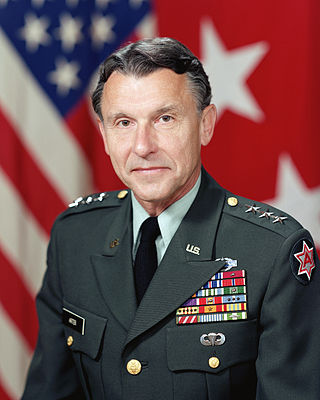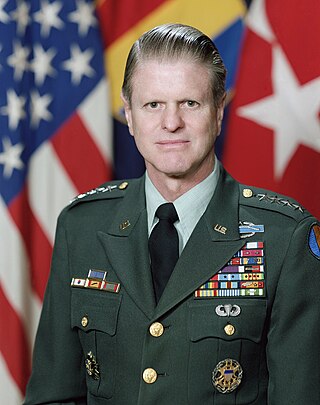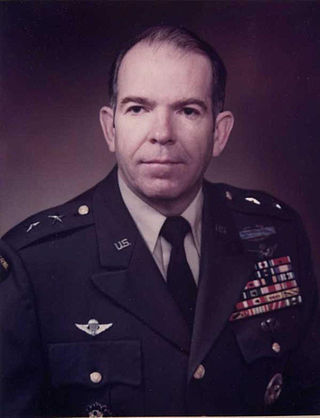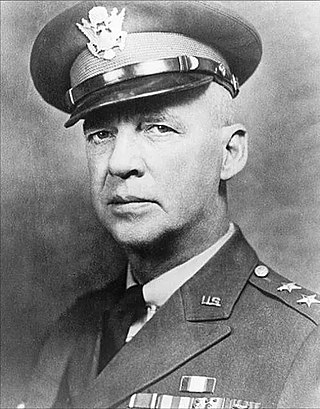
The School of Advanced Military Studies (SAMS) is one of four United States Army schools that make up the United States Army Command and General Staff College (CGSC) at Fort Leavenworth, Kansas. This "enormously rigorous" graduate school comprises three programs: the larger Advanced Military Studies Program (AMSP); the Advanced Strategic Leadership Studies Program (ASLSP), a Joint Military Professional Education II certified senior service college program for senior field-grade officers, and the Advanced Strategic Planning and Policy Program (ASP3), which supports officers in obtaining doctorates from civilian schools.

Harold Gregory Moore Jr. was a United States Army lieutenant general and author. He was awarded the Distinguished Service Cross, the U.S. Army's second-highest decoration for valor, and was the first of his West Point class (1945) to be promoted to brigadier general, major general, and lieutenant general.

Fort Leavenworth is a United States Army installation located in Leavenworth County, Kansas, in the city of Leavenworth. Built in 1827, it is the second oldest active United States Army post west of Washington, D.C., and the oldest permanent settlement in Kansas. Fort Leavenworth has been historically known as the "Intellectual Center of the Army."

John William "Jack" Vessey Jr. was a career officer in the United States Army. He attained the rank of general, and was most notable for his service as the tenth chairman of the Joint Chiefs of Staff.

Marine Corps University is a military education university system of the United States Marine Corps. It is part of the Naval University System and accredited by the Commission on Colleges of the Southern Association of Colleges and Schools to award Master's Degrees.

Edmund Louis "Snitz" Gruber was an artillery officer and general in the United States Army who also gained popularity as composer of military music. He served as Commandant of the Command and General Staff College from October 1940 to May 1941.

Robert Arter is a retired United States Army lieutenant general and former commanding general of the Sixth United States Army.

Edward Charles "Shy" Meyer was a United States Army general who served as the 29th Chief of Staff of the United States Army.

The U.S. Army Combined Arms Center (USACAC) is located at Fort Leavenworth and provides leadership and supervision for leader development and professional military and civilian education; institutional and collective training; functional training; training support; battle command; doctrine; lessons learned and specified areas the Commanding General, United States Army Training and Doctrine Command (TRADOC) designates in order to serve as a catalyst for change and to support developing relevant and ready expeditionary land formations with campaign qualities in support of the joint force commander.

General William Rowland Richardson was a United States Army four-star general and former commander of the United States Army Training and Doctrine Command.

Major General Edward Leonard King was an American football player and coach and officer in the United States Army. He played college football as the halfback at the United States Military Academy from 1894 to 1895 and served as the head coach of the Army football team in 1903. King was a career military officer who served in the Spanish–American War and World War I. He was the Commandant of the United States Army Command and General Staff College from 1925 to 1929 and attained the rank of major general.

Jacob Earl "Jake" Fickel was a general officer and an instructor of aviation in the United States Army. He served as a private, corporal and sergeant, prior to being commissioned an officer and rising to the rank of major general.

Benjamin Leslie Harrison was an officer in the United States Army who contributed to the tactics of modern airmobile warfare involving the integration of helicopters with infantry and armor forces for both rapid deployment and subsequent support. General Harrison was an early advocate, theorist and practitioner of these tactics, commonly referred to as "air assault." They are analogous to the revolutionary use of armor and air support with infantry in blitzkrieg warfare in early World War II, and are critical to modern military doctrine as practiced in Vietnam, Iraq and Afghanistan.

David Holmes Huntoon Jr. is a retired U.S. Army lieutenant general who served as the 58th Superintendent of the United States Military Academy at West Point, New York from 2010-2013.
The history of the United States Army School of Advanced Military Studies has its beginning in the early 1980s. It began as an additional year of study for selected graduates of the United States Army's Command and General Staff College at Fort Leavenworth, Kansas. Although there was some disagreement as to the course purpose, it settled into providing its students a "broad, deep military education in the science and art of war."

Oliver Williams Dillard Sr. was a United States Army major general, the fifth black officer in the U.S. Army to attain flag rank. He was a member of the Military Intelligence Hall of Fame and Officer Candidate School Hall of Fame, at Fort Huachuca, Arizona and Fort Benning, Georgia respectively.

Brigadier General Ronald Kirklin is a retired general officer in the United States Army. Kirklin was the 53rd Quartermaster General and Commandant of the Quartermaster School at Fort Lee, Virginia from 2014 to 2016.

Brigadier General Thomas R. Dickinson is a retired general officer in the United States Army and served as the 29th Chief of Ordnance and Commandant of the U.S. Army Ordnance School at Aberdeen Proving Grounds, Maryland.

Major General Robert David Shadley is a retired general officer in the United States Army and served as the Director of Logistics, G-4, for the United States Army Forces Command at Fort McPherson, Georgia. Prior to this assignment, he served as the 28th Chief of Ordnance and Commandant of the U.S. Army Ordnance School at Aberdeen Proving Grounds, Maryland.

Karl Truesdell was a career officer in the United States Army who attained the rank of major general and was a veteran of both World War I and World War II. He was most notable for his leadership assignments as commander of the 1st Infantry Division and VI Corps, and commandant of the United States Army Command and General Staff College.
























